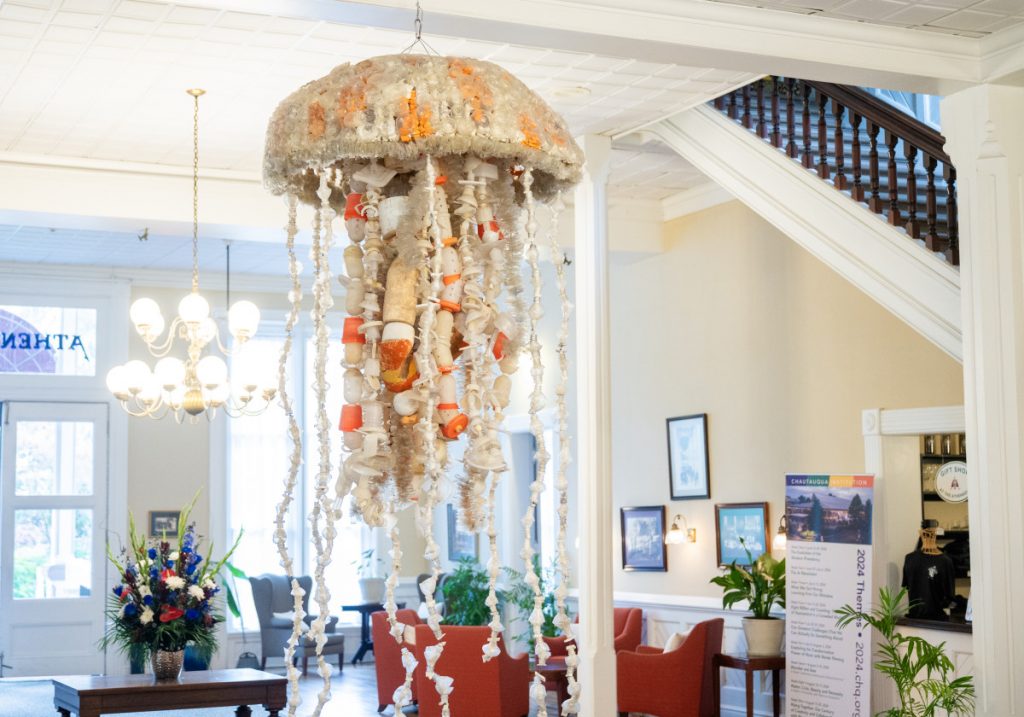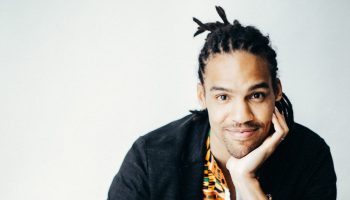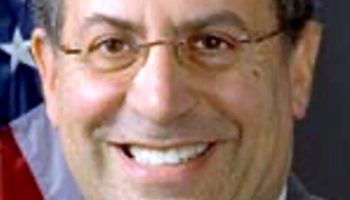
Mariia Novoselia
Staff writer
A white jellyfish with specks of orange splattered across its body hangs from the ceiling of the Athenaeum Hotel lobby, one of 14 sculptures in the “Washed Ashore – Art to Save the Sea” exhibit, made of debris collected from ocean shores in South Oregon.
Brad Parks, conservation and education director of the Washed Ashore organization, will talk about the project’s mission and the sculptures’ hopeful impact at 2 p.m. Saturday at Smith Wilkes Hall.

The project’s mission can be divided into three parts: 1) Creating beautiful art, 2) educating a global audience about plastic pollution in oceans and waterways, and 3) getting people to reflect on what they can do to solve this problem. In his presentation, Parks will pay special attention to the art of “Washed Ashore,” since art is one of the four pillars of Chautauqua Institution.
Parks said he will discuss how the sculptures are created and give the audience a virtual tour of the project’s home base in Bandon, Oregon, through a video created by their artistic director.
In Fall 2016, when serving as senior director of guest experiences at the Denver Zoo, Parks organized an exhibition there, the first inland venue to host “Washed Ashore.”
Working with the exhibit transformed him in many ways, he said, including which products he uses and which he chooses to avoid. As his first step, he examined his shopping habits.
For example, once he learned that most single-use coffee cups have plastic lining that prevent them from being recycled, Parks now carries around a reusable mug “religiously,” especially when traveling.
Avoiding something as familiar as plastic toothpaste tubes in favor of solid tablets has been more challenging, but even a small change can make a big difference, Parks said.
“When I have collected those toothpaste tubes that I’ve used over a period of time, it was shocking to actually see the volume that I go through as one individual,” he said.
Buying items made with reclaimed plastic from the ocean is another way to mitigate plastic pollution. In Parks’ case, he wears a bracelet made of beads that were once plastic water bottles. The accessory, he said, acts as a reminder to look for ways to support the environment and those who are helping it.
Over the last several years battling plastic pollution, Parks said he “had moments of losing hope,” especially during the COVID-19 pandemic. Because of single-use masks, gloves and plastic packaging, huge volumes of trash ended up in the ocean.
“I’m getting a little more hopeful, though,” he said, thanks in part to efforts like the one led by the United Nations, in which more than 100 participating countries are considering ways to reduce and eliminate plastic pollution.
“Washed Ashore” also gives individuals the opportunity to feel part of a collective action, Parks said.
Locally, Chautauqua Institution and its Climate Change Initiative have also been working to reduce plastic pollution on the grounds. Parks said the Institution has done “a great job in leading by example,” namely in replacing single-use plastic water bottles with aluminum ones, which are recyclable and can be used over and over again.
“There are so many ways plastic is involved in our daily life,” Parks said. “It does help us in many ways and has benefits, but it is also choking our planet.”
Parks suggested everyone can do their part by picking up plastic bottles or researching environmental issues.
Mark Wenzler, director of the Chautauqua Climate Initiative, said a permanent “Washed Ashore”-style sculpture may appear at the Institution this fall. The sculpture will represent the ecosystem of Chautauqua.
Plastic pollution, he said, is an issue that affects people and the environment everywhere, not just along the coast of the ocean.
“All the nearby creeks, rivers, streams … are connected and do lead to the ocean,” Parks said. “So everyone, no matter where they’re from, really can make an impact on this problem.”




